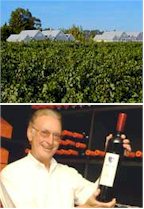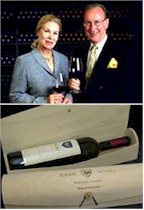


After 26 years in the Hong Kong airline industry, Baron Hans Rudolf Haan established Haan Estate Wines in 1993, acquiring 26.3 hectares near Tanunda. The original site Hanenhof was initially planted in 1853 by George Friedrich Schmidt, who purchased the property for a pound an acre. The celebrated Barossa Merlot virtuoso James Irvine, assisted in the establishment of Haan by restoring and replanting the ancient vines. He further left his legacy on Haan Estate by mentoring the winemakers. The 18-hectares surrounding Hanenhof Estate consist mainly of the sandy loam soils which dominate Barossa Valley floor. These soils have proven excellent for producing rich, luscious Shiraz and Cabernets, varieties that have made the Barossa famous throughout the world. Hans and Fransien Haan renovated an 1850s vintage farmhouse, with a cottage, studio and tennis court, to make a homestead winery with a beautiful garden.

Barossa remains a unique district that maintains many of the great traditions lost in other areas. The local Barossa inhabitants work towards a strong commitment to preserving a great vineyard heritage. Barossa is blessed with a climate that exhibits four very distinct seasons, and a wonderful sense of community where everyone works together for the common good, taking pride in the achievements of one and all. The Haan philosophy meant that Hanenhof Vineyards would be holistically managed as a true wine estate. Providing the best possible conditions in the vineyard has been the key to success, along with a clear understanding of how to achieve excellence in the winemaking.
Plantings include shiraz and cabernet sauvignon, merlot and viognier, cabernet franc, malbec and petit verdot. All of the production receives excellent attention to detail from the dedicated Haan vineyard team.
Grapes are picked at optimum maturity for each wine type, treated to a gentle fermentation and transferred into French oak barriques to mature. The barriques are housed in the beautifully designed maturation cellars that dominate the entrance to the Estate's buildings.

All vines in the Haan vineyard are cane pruned with 30 buds to the vine and vertical shoot positioning to give a ballerina effect. Water management is essential and the key to a good harvest. The grapes are harvested at their optimum ripeness and processed with as little intervention as possible. Grapes are destemmed and fermented in small batches. Elevage is in a mixture of new and older barriques and hogheads for both the Classic and Prestige range. The use of both American oak, which offers a sweeter spice profile, and French oak - which shows more savoury spices and delicate tannin profile, helps to create wines of power and elegance.
Depending on the variety, the wines may remain in oak for up to 24 months, followed by further bottle maturation prior to release, with the eventual aim that the red wines will be available at around 2.5 years of age. Most of the vines are on a simple vertical trellis system with moving wires to lift the foliage and expose the fruit to the sun for full development of flavour and character. The Haan philosophy of providing the best possible conditions in the vineyard in order to encourage the most outstanding result in the bottle has certainly been rewarded with outstanding wines. Haan ultimately triumphed with the highly coveted Australian Wine Producer of Year, followed by Trophy and Medals for outstanding successes at the London International Wine & Spirit Competition.
